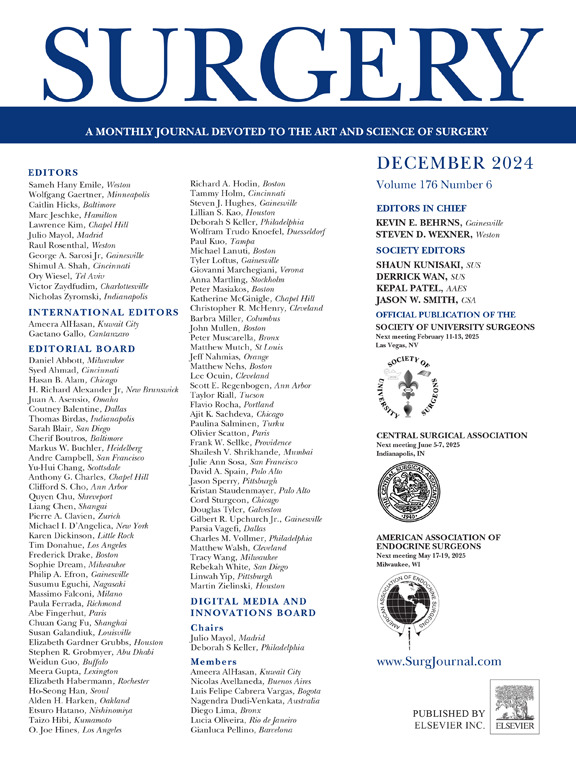中心静脉置管训练的高表面相似性与高功能任务对齐模拟:一项随机交叉试验
IF 3.2
2区 医学
Q1 SURGERY
引用次数: 0
摘要
程序技能模拟中的逼真度可分为表面相似性(模拟器接近真实组织外观)或功能任务一致性(模拟的关键步骤接近真实程序的关键步骤)。我们假设在中心静脉置管训练中,住院医师更喜欢具有高功能任务一致性的模拟模型,而不是具有高表面相似性和低功能任务一致性的模型。方法我们进行了一项随机交叉试验,纳入了来自多个专业的住院医生。我们比较了具有高表面相似性(头部、颈部和上肢)和低功能任务一致性的以外观为中心的模型与具有高功能任务一致性的以功能为中心的模型(在单个模型中使用超声引导复制中心静脉导管过程,包括血管识别、扩张和导管引入)和低表面相似性的模型。参与者使用每个模型一次(交叉),顺序随机分配。在使用每个模型后,他们使用5分制对表面相似性(超声图像、组织感觉、针和换能器功能、模型整体)和功能任务一致性(动作、步骤顺序、步骤之间的连续性、任务整体)进行评分。最后,参与者在使用两种模拟器后对自己的偏好进行打分。结果共邀请80名居民参与,其中53人(66%)完成了研究。比较功能中心模型和外观中心模型的即时模拟器后评估显示,功能中心模型在几个领域的平均得分明显更高,包括组织感觉(2.9±1.04 vs 2.4±0.95,P = 0.027),针和换能器功能(3.3±1.11 vs 2.8±1.05,P = 0.007),模型整体(3.4±0.98 vs 2.6±0.93,P <;.001)和任务连续性(4.0±1.04 vs 2.7±1.25,P <;措施)。此外,在整体任务对齐方面,以功能为中心的模型明显优于以外观为中心的模型(3.6±0.95 vs 2.8±1.0,P <;措施)。对模拟器的总体偏好表明,参与者更倾向于在未来的培训中使用以功能为中心的模型(87%,n = 46)。结论住院医师对以功能为中心的模拟器的总体表面相似性和功能任务一致性的所有测量都给予了更高的评价,与以外观为中心的模拟器相比,他们总体上更喜欢这个模型。此外,他们表现出对功能任务一致性的强烈偏好。本文章由计算机程序翻译,如有差异,请以英文原文为准。
High superficial resemblance versus high functional task alignment simulation for central venous catheterization training: A randomized crossover trial
Introduction
Fidelity in procedural skills simulation can be classified as superficial resemblance (simulator approximates real tissue appearance) or functional task alignment (key steps of simulation approximate those of real procedure). We hypothesized that resident physicians would prefer a simulation model with high functional task alignment over a model with higher superficial resemblance and lower functional task alignment in central venous catheter placement training.
Methods
We conducted a randomized crossover trial, enrolling residents from multiple specialties. We compared an Appearance-focused model with high superficial resemblance (head, neck, and upper torso) and low functional task alignment vs a function-focused model with high functional task alignment (replicates the process central venous catheter using ultrasound guidance including vascular identification, dilation, and catheter introduction in a single model) and lower superficial resemblance. Participants used each model once (crossover), with sequence randomly assigned. After using each model, they rated the superficial resemblance (ultrasonographic image, tissue feel, needle and transducer functionality, model as a whole) and functional task alignment (movements, steps sequence, continuity between steps, task as a whole) using a 5-point scale. Finally, participants rated their preference after using both simulators.
Results
Eighty residents were invited to participate, with 53 (66%) completing the study. Immediate post simulator assessments comparing Function-focused and Appearance-focused models demonstrated significantly higher mean scores for the Function-focused model across several domains, including tissue feels (2.9 ± 1.04 vs 2.4 ± 0.95, P = .027), needle and transducer functionality (3.3 ± 1.11 vs 2.8 ± 1.05, P = .007), model as a whole (3.4 ± 0.98 vs 2.6 ± 0.93, P < .001), and task continuity (4.0 ± 1.04 vs 2.7 ± 1.25, P < .001). Furthermore, the Function-focused model notably outperformed the Appearance-focused model regarding the overall task alignment (3.6 ± 0.95 vs 2.8 ± 1.0, P < .001). The overall preference for the simulators indicated a clear inclination toward the Function-focused model with participants preferring it for future training (87%, n = 46).
Conclusion
Resident physicians rated the function-focused simulator higher for both overall superficial resemblance and for all measures of functional task alignment, and preferred this model overall, in comparison with the appearance-focused simulator. Additionally, they demonstrated a strong preference for functional task alignment.
求助全文
通过发布文献求助,成功后即可免费获取论文全文。
去求助
来源期刊

Surgery
医学-外科
CiteScore
5.40
自引率
5.30%
发文量
687
审稿时长
64 days
期刊介绍:
For 66 years, Surgery has published practical, authoritative information about procedures, clinical advances, and major trends shaping general surgery. Each issue features original scientific contributions and clinical reports. Peer-reviewed articles cover topics in oncology, trauma, gastrointestinal, vascular, and transplantation surgery. The journal also publishes papers from the meetings of its sponsoring societies, the Society of University Surgeons, the Central Surgical Association, and the American Association of Endocrine Surgeons.
 求助内容:
求助内容: 应助结果提醒方式:
应助结果提醒方式:


